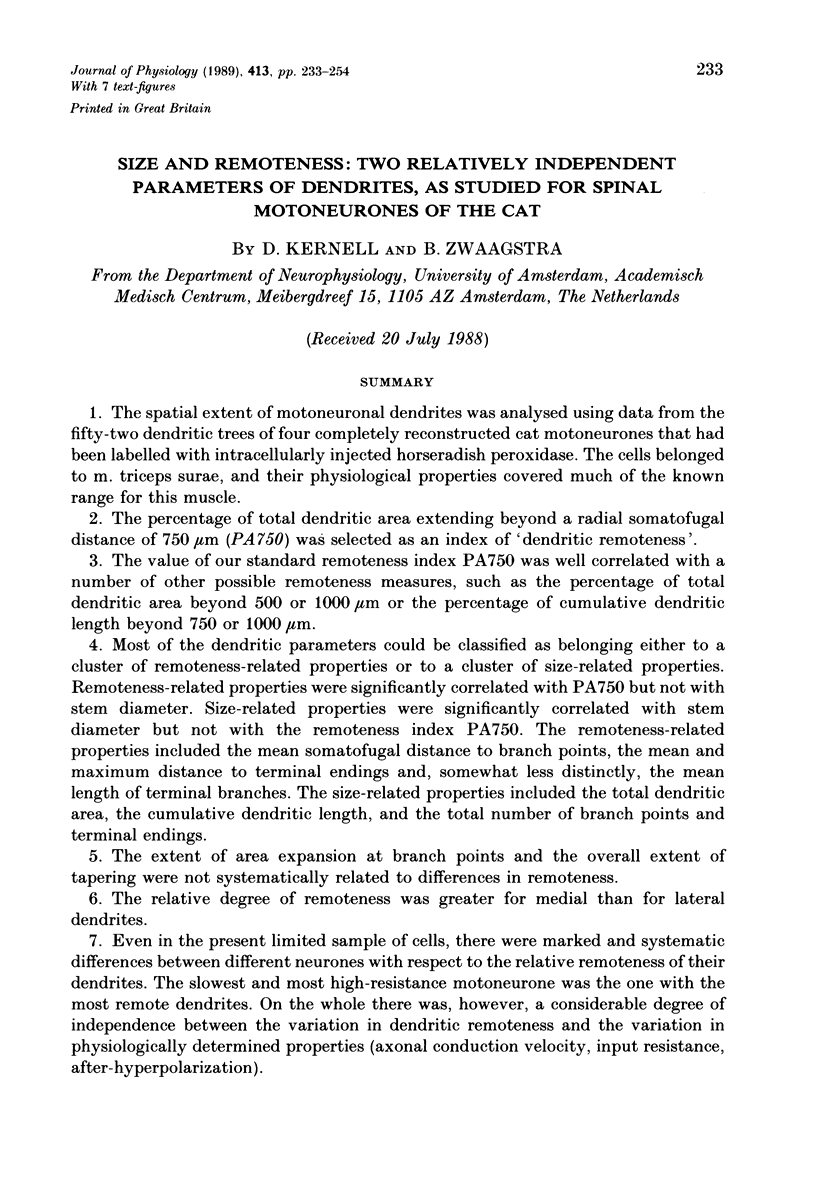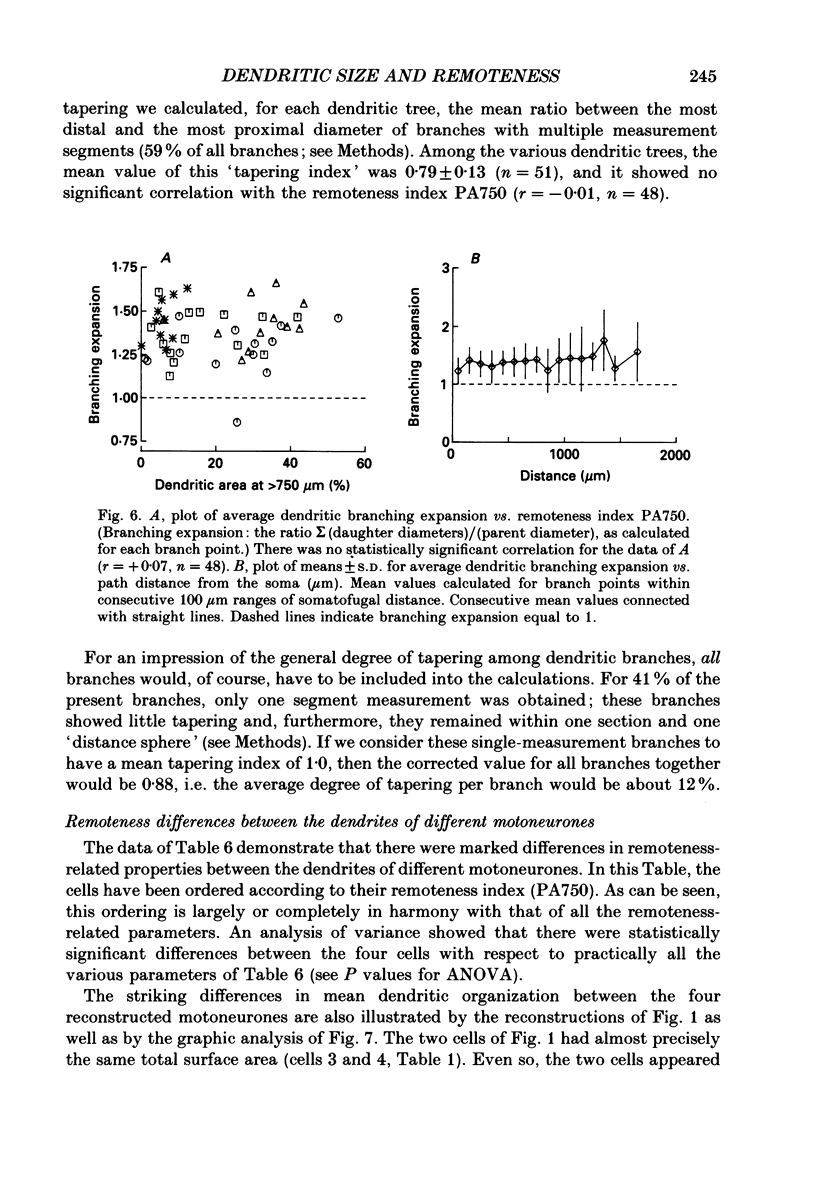Abstract
1. The spatial extent of motoneuronal dendrites was analysed using data from the fifty-two dendritic trees of four completely reconstructed cat motoneurones that had been labelled with intracellularly injected horseradish peroxidase. The cells belonged to m. triceps surae, and their physiological properties covered much of the known range for this muscle. 2. The percentage of total dendritic area extending beyond a radial somatofugal distance of 750 microns (PA750) was selected as an index of 'dendritic remoteness'. 3. The value of our standard remoteness index PA750 was well correlated with a number of other possible remoteness measures, such as the percentage of total dendritic area beyond 500 or 1000 microns or the percentage of cumulative dendritic length beyond 750 or 1000 microns. 4. Most of the dendritic parameters could be classified as belonging either to a cluster of remoteness-related properties or to a cluster of size-related properties. Remoteness-related properties were significantly correlated with PA750 but not with stem diameter. Size-related properties were significantly correlated with stem diameter but not with the remoteness index PA750. The remoteness-related properties included the mean somatofugal distance to branch points, the mean and maximum distance to terminal ending and, somewhat less distinctly, the mean length of terminal branches. The size-related properties included the total dendritic area, the cumulative dendritic length, and the total number of branch points and terminal endings. 5. The extent of area expansion at branch points and the overall extent of tapering were not systematically related to differences in remoteness. 6. The relative degree of remoteness was greater for medial than for lateral dendrites. 7. Even in the present limited sample of cells, there were marked and systematic differences between different neurones with respect to the relative remoteness of their dendrites. The slowest and most high-resistance motoneurone was the one with the most remote dendrites. On the whole there was, however, a considerable degree of independence between the variation in dendritic remoteness and the variation in physiologically determined properties (axonal conduction velocity, input resistance, after-hyperpolarization). 8. In the discussion it is suggested that differences in dendritic remoteness might lead to a selectivity between the various members of a given motoneurone pool with respect to their reception of topographically distributed systems of synapses. It is proposed that such differences might be of interest in relation to, for instance, the organization of innervation to motoneurones belonging to different task groups within the same muscle.
Full text
PDF





















Selected References
These references are in PubMed. This may not be the complete list of references from this article.
- Barrett J. N., Crill W. E. Specific membrane properties of cat motoneurones. J Physiol. 1974 Jun;239(2):301–324. doi: 10.1113/jphysiol.1974.sp010570. [DOI] [PMC free article] [PubMed] [Google Scholar]
- Bras H., Gogan P., Tyc-Dumont S. The dendrites of single brain-stem motoneurons intracellularly labelled with horseradish peroxidase in the cat. Morphological and electrical differences. Neuroscience. 1987 Sep;22(3):947–970. doi: 10.1016/0306-4522(87)92972-1. [DOI] [PubMed] [Google Scholar]
- Brown A. G., Fyffe R. E. Direct observations on the contacts made between Ia afferent fibres and alpha-motoneurones in the cat's lumbosacral spinal cord. J Physiol. 1981;313:121–140. doi: 10.1113/jphysiol.1981.sp013654. [DOI] [PMC free article] [PubMed] [Google Scholar]
- Burke R. E., Dum R. P., Fleshman J. W., Glenn L. L., Lev-Tov A., O'Donovan M. J., Pinter M. J. A HRP study of the relation between cell size and motor unit type in cat ankle extensor motoneurons. J Comp Neurol. 1982 Jul 20;209(1):17–28. doi: 10.1002/cne.902090103. [DOI] [PubMed] [Google Scholar]
- Burke R. E., Jankowska E., ten Bruggencate G. A comparison of peripheral and rubrospinal synaptic input to slow and fast twitch motor units of triceps surae. J Physiol. 1970 May;207(3):709–732. doi: 10.1113/jphysiol.1970.sp009090. [DOI] [PMC free article] [PubMed] [Google Scholar]
- Cameron W. E., Averill D. B., Berger A. J. Quantitative analysis of the dendrites of cat phrenic motoneurons stained intracellularly with horseradish peroxidase. J Comp Neurol. 1985 Jan 1;231(1):91–101. doi: 10.1002/cne.902310108. [DOI] [PubMed] [Google Scholar]
- Cullheim S., Fleshman J. W., Glenn L. L., Burke R. E. Membrane area and dendritic structure in type-identified triceps surae alpha motoneurons. J Comp Neurol. 1987 Jan 1;255(1):68–81. doi: 10.1002/cne.902550106. [DOI] [PubMed] [Google Scholar]
- Cullheim S., Fleshman J. W., Glenn L. L., Burke R. E. Three-dimensional architecture of dendritic trees in type-identified alpha-motoneurons. J Comp Neurol. 1987 Jan 1;255(1):82–96. doi: 10.1002/cne.902550107. [DOI] [PubMed] [Google Scholar]
- Egger M. D., Egger L. D. Quantitative morphological analysis of spinal motoneurons. Brain Res. 1982 Dec 16;253(1-2):19–30. doi: 10.1016/0006-8993(82)90669-2. [DOI] [PubMed] [Google Scholar]
- FRANK K., FUORTES M. G. Stimulation of spinal motoneurones with intracellular electrodes. J Physiol. 1956 Nov 28;134(2):451–470. doi: 10.1113/jphysiol.1956.sp005657. [DOI] [PMC free article] [PubMed] [Google Scholar]
- Kernell D., Zwaagstra B. Dendrites of cat's spinal motoneurones: relationship between stem diameter and predicted input conductance. J Physiol. 1989 Jun;413:255–269. doi: 10.1113/jphysiol.1989.sp017652. [DOI] [PMC free article] [PubMed] [Google Scholar]
- Kernell D., Zwaagstra B. Input conductance axonal conduction velocity and cell size among hindlimb motoneurones of the cat. Brain Res. 1981 Jan 12;204(2):311–326. doi: 10.1016/0006-8993(81)90591-6. [DOI] [PubMed] [Google Scholar]
- Loeb G. E. The control and responses of mammalian muscle spindles during normally executed motor tasks. Exerc Sport Sci Rev. 1984;12:157–204. [PubMed] [Google Scholar]
- ROMANES G. J. The motor cell columns of the lumbo-sacral spinal cord of the cat. J Comp Neurol. 1951 Apr;94(2):313–363. doi: 10.1002/cne.900940209. [DOI] [PubMed] [Google Scholar]
- Rose P. K., Keirstead S. A., Vanner S. J. A quantitative analysis of the geometry of cat motoneurons innervating neck and shoulder muscles. J Comp Neurol. 1985 Sep 1;239(1):89–107. doi: 10.1002/cne.902390108. [DOI] [PubMed] [Google Scholar]
- Rose P. K., Richmond F. J. White-matter dendrites in the upper cervical spinal cord of the adult cat: a light and electron microscopic study. J Comp Neurol. 1981 Jun 20;199(2):191–203. doi: 10.1002/cne.901990204. [DOI] [PubMed] [Google Scholar]
- Streit P., Reubi J. C. A new and sensitive staining method for axonally transported horseradish peroxidase (HRP) in the pigeon visual system. Brain Res. 1977 May 13;126(3):530–537. doi: 10.1016/0006-8993(77)90603-5. [DOI] [PubMed] [Google Scholar]
- Ulfhake B., Cullheim S. A quantitative light microscopic study of the dendrites of cat spinal gamma -motoneurons after intracellular staining with horseradish peroxidase. J Comp Neurol. 1981 Nov 10;202(4):585–596. doi: 10.1002/cne.902020410. [DOI] [PubMed] [Google Scholar]
- Ulfhake B., Kellerth J. O. A quantitative light microscopic study of the dendrites of cat spinal alpha-motoneurons after intracellular staining with horseradish peroxidase. J Comp Neurol. 1981 Nov 10;202(4):571–583. doi: 10.1002/cne.902020409. [DOI] [PubMed] [Google Scholar]
- Ulfhake B., Kellerth J. O. A quantitative morphological study of HRP-labelled cat alpha-motoneurones supplying different hindlimb muscles. Brain Res. 1983 Mar 28;264(1):1–19. doi: 10.1016/0006-8993(83)91116-2. [DOI] [PubMed] [Google Scholar]
- Ulfhake B., Kellerth J. O. Does alpha-motoneurone size correlate with motor unit type in cat triceps surae? Brain Res. 1982 Nov 18;251(2):201–209. doi: 10.1016/0006-8993(82)90738-7. [DOI] [PubMed] [Google Scholar]
- Ulfhake B., Kellerth J. O. Electrophysiological and morphological measurements in cat gastrocnemius and soleus alpha-motoneurones. Brain Res. 1984 Jul 30;307(1-2):167–179. doi: 10.1016/0006-8993(84)90471-2. [DOI] [PubMed] [Google Scholar]
- Westbury D. R. A comparison of the structures of alpha and gamma-spinal motoneurones of the cat. J Physiol. 1982 Apr;325:79–91. doi: 10.1113/jphysiol.1982.sp014137. [DOI] [PMC free article] [PubMed] [Google Scholar]
- Zengel J. E., Reid S. A., Sypert G. W., Munson J. B. Membrane electrical properties and prediction of motor-unit type of medial gastrocnemius motoneurons in the cat. J Neurophysiol. 1985 May;53(5):1323–1344. doi: 10.1152/jn.1985.53.5.1323. [DOI] [PubMed] [Google Scholar]
- Zwaagstra B., Kernell D. Sizes of soma and stem dendrites in intracellularly labelled alpha-motoneurones of the cat. Brain Res. 1981 Jan 12;204(2):295–309. doi: 10.1016/0006-8993(81)90590-4. [DOI] [PubMed] [Google Scholar]
- Zwaagstra B., Kernell D. The duration of after-hyperpolarization in hindlimb alpha motoneurones of different sizes in the cat. Neurosci Lett. 1980 Oct 2;19(3):303–307. doi: 10.1016/0304-3940(80)90278-5. [DOI] [PubMed] [Google Scholar]


